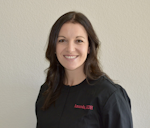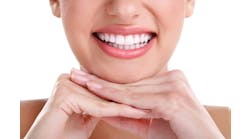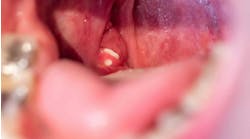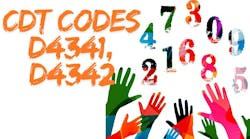“Inclusion is an organizational effort and practices in which different groups or individuals having different backgrounds are culturally and socially accepted and welcomed, and equally treated.”1
When we go to a dental office, we all want to be embraced, hearing loss or not. It is estimated that 466 million people in the world have hearing loss.2 Being one of these people—as well as a mom, a registered dental hygienist, and an executive director of my own nonprofit organization—making sure all people feel included and informed is at the top of my priorities.
In our profession, keeping people informed and communicating clearly can help calm potentially nervous patients. I work hard at my job to make sure our office uses clear masks, pen and paper, notes on the computer screen, text messaging, and more to communicate with patients. I’ve witnessed too many people become uncomfortable and awkward around someone who has hearing loss. But I want everyone to understand that they should treat people with hearing loss just like they would treat anyone else.
Advocate for inclusion
COVID-19 has impacted people with hearing loss by exposing many underlying inequalities this population faces. Requesting accommodations can make people with hearing loss feel like a burden. During the pandemic, we were left to face situations alone when we usually would have a support person with us or at the very least be able to see lips in order to lip-read. We’re often left alone in doctors’ offices without a significant other or interpreter to help with communication needs.
Imagine trying to order food alone at a restaurant. You request that the person remove their mask so you can understand them, but if they refuse to help you, you’re left with the wrong orders or both parties feeling frustrated. Masked communications create barriers upon those who lip-read or require facial expressions when communicating in American Sign Language or oral speech.
In the past, we were used to hearing fragments of sentences, and now we must use our eyes and ears more to understand what’s going on. We’re working overtime to fill in the blanks of what we are missing from the times we could watch facial expressions.
Many of us who are deaf or hard of hearing and work in the health-care field rely heavily on lip-reading. We used to be able to pull down our masks and were not required to wear masks pre–COVID-19. Today, we must fight for accommodations such as clear masks. I have a difficult time hearing at work due to background noise from the instruments and other sounds, and this creates anxiety because I know I may not be hearing coworkers and patients correctly or at all, and I could potentially make a mistake.
Related content
Can you hear me now? Occupational noise-induced hearing loss among dental professionals
Hearing loss and dental professionals: A growing concern
Cultural competence: Developing and implementing best practices in dentistry
With these new challenges in place, it requires extra effort to get out of the house and face the world muffled. We know we are entering a hearing world, yet we are stripped of some of the tools that allow us to communicate and feel like we are a part of it. The inability to participate in conversations and feeling left out are magnified. With these barriers in place, many people do not know how to provide accessibility or have never even had to think about it. It was up to us to show them what is required for us to participate in life; our community had to be an advocate for our inclusion.The invisible burden
The Americans with Disabilities Act (ADA) of 1990 ensures that people with disabilities have the same rights and opportunities as everyone else.3 The law protects individuals with disabilities from discrimination in all areas of life, including jobs, educational settings, and transportation. Having this law acknowledges diversity, conveys respect for all people, is sensitive to differences, and promotes equal opportunities. A lot of employers have an equal opportunity employer statement under a job description to show they commit to inclusion and do their best to follow the ADA. However, due to a lack of knowledge, they may not know how to best make accommodations for their employees; in many cases. employees need to lead the way by showing what they require to perform. It’s OK to make your needs known because we’re protected by the law. But just because an office is willing to adhere to the law doesn’t mean they know what their employees need.
Many people feel uncomfortable when they encounter someone with hearing loss in a professional setting. This can add stress to an already-nervous individual. Many hearing people think of hearing loss as someone who uses sign language, but this isn’t always the case. Simply ask, “How can we help?” so they can explain their needs and the accommodation to provide. It may be as easy as making sure they can see your lips, adding captions to work presentations, preferred seating, etc.
If you notice someone has hearing loss but hasn’t discussed their disability with you, it’s likely they’re afraid of displaying it due to fear of unfair advantages, feeling devalued, and challenges when asking for clarification and understanding. Many of us don’t fit the stereotype of what hearing loss “looks like,” so we’re constantly having to demonstrate that we have a disability. We may not get the accommodations we need because we don’t look like we have a disability. There’s no denying the invisible burden.
Have the conversation
A good dental office has resources for those with hearing loss. Having empathy can go a long way. Understanding the disability leads to a more inclusive dental office. In doing so, you’re acting in the best interests of the community.
I think we often reinforce ableism because there is a lack of awareness and education about the disability. People tiptoe around trying to ask questions without coming off as offensive. Parents teach their kids not to stare or tell them not to ask questions, but education removes barriers so that people aren’t afraid.
I understand boundaries are different for everyone, so asking questions that are genuine and appropriate can open doors to greater understanding and better relationships, both of which lead to greater inclusion. If a question is inappropriate, I will say, “I’d be happy to answer that, but we’d prefer when it’s asked or worded this way” (and explain it). Or perhaps, “I prefer not to answer that but here’s a good way to find your answer to the question.” The person asking the question should understand and think, “OK, she wants to teach me and help me understand, but maybe the way I said it came off sounding offensive.”
Be aware of your tone of voice when asked to repeat yourself. Huffing, sighing, or getting snappy are obvious and can be hurtful. People are curious, and that’s OK. Don’t let fear get in the way of communication. Presume competence and speak to the person directly. Engage in the same conversation you would have with any other person. Inclusion works by being open-minded, willing to learn about and respect other people’s situations, and adapting situations to be more inclusive. We are all humans no matter what our abilities are, so treat every person as such and try to be understanding and helpful.
References
- What is diversity and inclusion? Global Diversity Practice Ltd. https://globaldiversitypractice.com/what-is-diversity-inclusion/
- Deafness and hearing loss. World Health Organization. April 1, 2021. https://www.who.int/news-room/fact-sheets/detail/deafness-and-hearing-loss
- Laws and regulations. Americans with Disabilities Act. U.S. Department of Labor. https://www.dol.gov/general/topic/disability/laws
Editor's note: This article appeared in the November 2021 print edition of RDH.
Additional reading: How PPE for COVID-19 impacts patient communication
Amanda Zubricki, BS, RDH, has a BS in psychology from Towson University. She graduated from Northern Virginia Community College with a dental hygiene degree in 2017 and holds licenses in Virginia, Texas, and North Carolina. Zubricki was born profoundly deaf but has never let it get in her way! She operates That Deaf RDH, a nonprofit with a vision to ensure that every deaf or hard-of-hearing person has the financial and community support they need to achieve their goal of becoming a dental hygienist. Visit her inspiring blog, That Deaf Girl.







